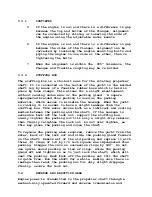
7.2
CONTINUED
helps, as does keeping the halyards tied away from the mast.
The pulp1t bales and lifelines are convenient places to attach
the halyards.
Periodically, take a trip aloft to check the entire rig. Look
for signs of chafe and check all nuts, bolts, screws, cotter
keys, blocks, and masthead sheaves. Make sure the spreader tips
are well covered with tape, leather or commercial boot to
protect the sails from
chafe and tearing. Take along a rag
and bucket of fresh water to clean the rigging and mast on your
way up. A clean rig means clean sails. On your way down, re-
apply whatever protective coating you have decided to use on the
mast and your work aloft is done till the next.
The halyards, sheets, and guys along with all rope and wire
Splices should be carefully checked before and after each sail
for wear. Wire rigging must be examined for broken strands and
signs of frayed sections. Particularly close scrutiny should be
given to those sections which rest on sheaves. The lines
supplied with your boat are braid construction, have little
stretch and wear very well if not abused. Sheets and vangs often
lead where they will rub together or chafe on lifelines.
By adjusting leads or by applying inexpensive chafing gear,
expensive damage may be prevented. When not in use, running
rigging should be tied away from the mast or neatly coiled and
hung in regular locations where it can readily be found. Frayed
ends should be burned and whipped and chafed eye splices should
be re spliced All blocks, sheaves, turnbuckles and winches used
in conjunction with running rigging should be lubricated
periodically with a light grease.
If you keep the stainless hardware on your boat free of marine
growth and polished, it will last longer and look better.
Saltwater sailors must hose off with fresh water after a hard
wet sail, and a rub down with a chamois helps.
7.3 FIBERGLAS SURFACES
The glossy outer surface of your laminated fiberglass boat is
known as gelcoat, a polyester resin, into which coloring
pigments and weathering, retardants have been incorporated. It
should be hosed with fresh water after every outing and
routinely washed, with a good detergent. Use a sponge on the
smooth surfaces, while a stiff deck brush will be helpful on the
non-skid surfaces, followed by more fresh water to avoid
streaking the topsides. Do not use abrasive cleaners as they
will rapidly dull the gelcoat surface.
Summary of Contents for 299
Page 1: ......
Page 2: ......
Page 53: ......
Page 54: ......
Page 55: ......
Page 56: ......
Page 57: ......
Page 58: ......
Page 59: ......
Page 60: ......
Page 61: ......
Page 62: ......
Page 63: ......
Page 64: ......
Page 65: ......
Page 66: ......
Page 67: ......
Page 68: ......
Page 69: ......
Page 70: ......
Page 71: ......
Page 72: ......
















































